
A cookie, or a biscuit, is a baked or cooked snack or dessert that is typically small, flat and sweet. It usually contains flour, sugar, egg, and some type of oil, fat, or butter. It may include other ingredients such as raisins, oats, chocolate chips, nuts, etc.

Dessert wines, sometimes called pudding wines in the United Kingdom, are sweet wines typically served with dessert.
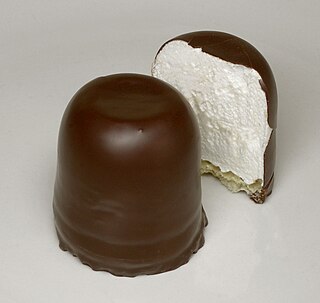
Chocolate-coated marshmallow treats also known as Chocolate teacakes are confections consisting of a biscuit base topped with marshmallow-like filling and then coated in a hard shell of chocolate. They were invented in Denmark in the 19th century and later also produced and distributed by Viau in Montreal as early as 1901. Some variants of these confections have previously been known in many countries by names comprising equivalents of the English word "negro".

A biscuit is a flour-based baked and shaped food product. In most countries biscuits are typically hard, flat, and unleavened. They are usually sweet and may be made with sugar, chocolate, icing, jam, ginger, or cinnamon. They can also be savoury, similar to crackers. Types of biscuit include sandwich biscuits, digestive biscuits, ginger biscuits, shortbread biscuits, chocolate chip cookies, chocolate-coated marshmallow treats, Anzac biscuits, biscotti, and speculaas.

Gingerbread refers to a broad category of baked goods, typically flavored with ginger, cloves, nutmeg, and cinnamon and sweetened with honey, sugar, or molasses. Gingerbread foods vary, ranging from a moist loaf cake to forms nearly as crisp as a ginger snap.
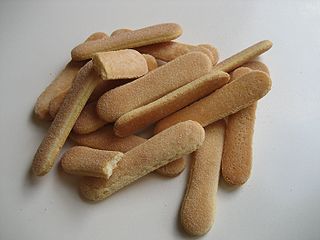
Ladyfingers, or in British English sponge fingers also known in the Haredi Jewish community as baby fingers, are low-density, dry, egg-based, sweet sponge cake biscuits roughly shaped like large fingers. They are a principal ingredient in many dessert recipes, such as trifles and charlottes, and are also used as fruit or chocolate gateau linings, and sometimes for the sponge element of tiramisu. They are typically soaked in a sugar syrup or liqueur, or in coffee or espresso for tiramisu. Plain ladyfingers are commonly given to infants, being soft enough for teething mouths, but easy to grasp and firm enough not to fall apart.

Fazer is one of the largest corporations in the Finnish food industry. The company was founded by Karl Fazer in 1891, as a "French-Russian confectionery" in central Helsinki. Today, it employs over ten thousand people across Finland, Sweden, Russia, Denmark, Norway, Estonia, Latvia, Lithuania and Japan. Its products are exported to almost 40 countries.

Christmas cookies or Christmas biscuits are traditionally sugar cookies or biscuits cut into various shapes related to Christmas.

Universal Robina Corporation (URC) is a Philippine company based in Quezon City, Philippines. It is one of the largest food and beverage companies in the Philippines.
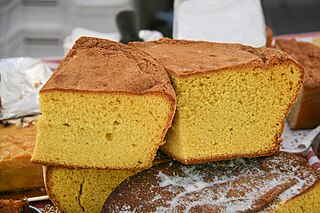
Bizcocho is the name given in the Spanish-speaking world to a wide range of pastries, cakes or cookies. The exact product to which the word bizcocho is applied varies widely depending on the region and country. For instance, in Spain bizcocho is exclusively used to refer to sponge cake. In Uruguay, most buttery flaky pastry including croissants are termed bizcocho, whilst sponge cake is called bizcochuelo. In Chile, the Dominican Republic and Bolivia bizcocho refers to a sweet dough (masa) baked with local ingredients, similar to the bizcocho from Spain. In Ecuador the dough of a bizcocho can either be sweet or salty. The US state New Mexico is unusual in using the diminutive form of the name, bizcochito, as the name for a locally developed and very popular cookie.
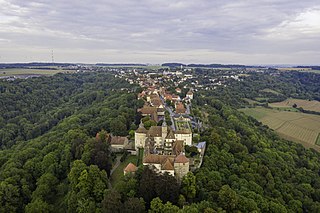
Langenburg is a town in the district of Schwäbisch Hall, in Baden-Württemberg, Germany. It is located on a hill above the river Jagst, 18 km northeast of Schwäbisch Hall. It is also the place where Wibele - small, sweet, biscuit-like pastries - were invented and are still baked today.
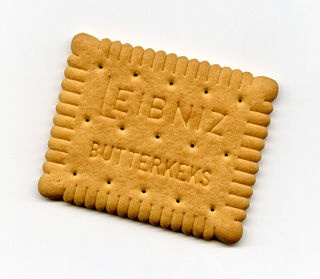
The Leibniz-Keks or Choco Leibniz is a German brand of biscuit or cookie produced by the Bahlsen food company since 1891. It was created by the firm as a rival to a similar French biscuit, the Petit-Beurre.
Langenburg is a town in the rural municipality of Langenburg No. 181, located within the Saskatchewan Association of Rural Municipalities SARM Division No. 1 and Census Division No. 5, in the Canadian province of Saskatchewan.
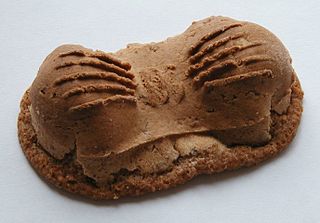
Muskazine is the name of a German specialty made from almonds, spices, sugar, flour and eggs. It is produced by two cafés in Dettelbach, Germany, throughout the entire year. The biscuits look like a Saint James scallop. It was first mentioned in Literature in 1691 and originates in southern Germany. It is also known in Austria, where it was first mentioned in 1790

An Afghan is a traditional New Zealand biscuit made from flour, butter, cornflakes, sugar and cocoa powder, topped with chocolate icing and a half walnut. The recipe has a high proportion of butter, and relatively low sugar, and no leavening, giving it a soft, dense and rich texture, with crunchiness from the cornflakes, rather than from a high sugar content. The high butter content gives a soft melt-in-the-mouth texture, and the sweetness of the icing offsets the low sugar and the cocoa bitterness.
Győri is a brand name for biscuit products and candies owned by the Győri Keksz Ltd., Hungary. In its early years the production took place in Győr with the help of only 50 professionals. In its most successful years, however, the company employed around 1000 people and offered 334 different goods.
The following outline is provided as an overview of and topical guide to chocolate:

A cat tongue is a small biscuit (cookie) or chocolate bar available in a number of European, Asian, and South American countries.
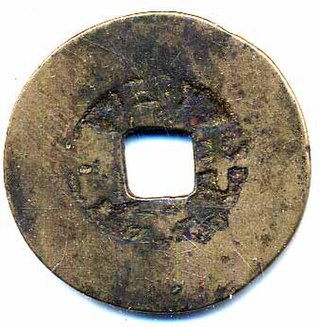
Bingqian, or Bingxingqian, is a term, which translates into English as "biscuit coins", "pie coins", or "cake coins", used by mainland Chinese and Taiwanese coin collectors to refer to cash coins with an extremely broad rim as, these cash coins can also be very thick. While the earliest versions of the Bingqian did not extraordinarily broad rims.
















